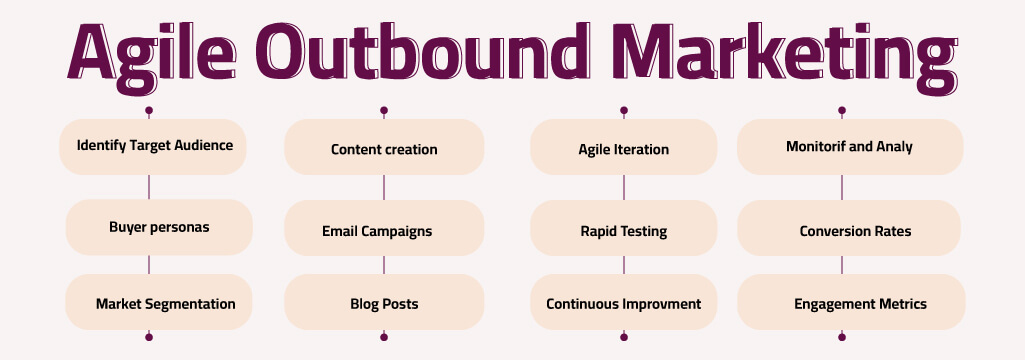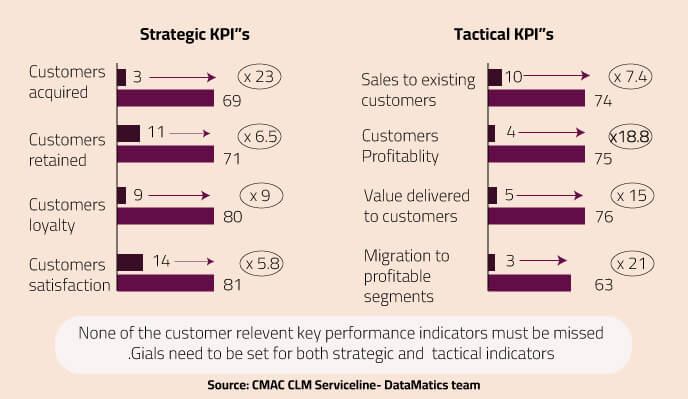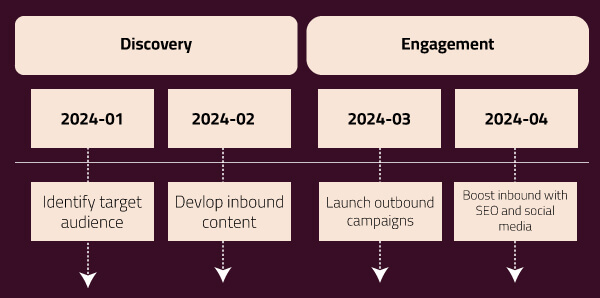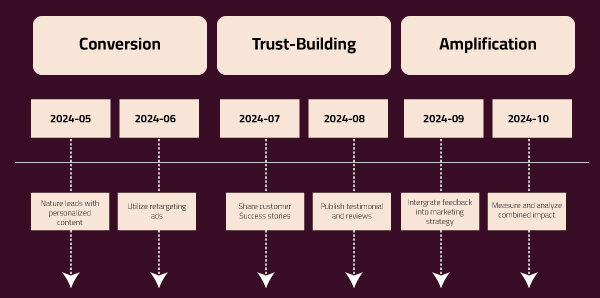
How to Build Brand Resilience With Outbound Marketing
PwC's Global Crisis and Resilience Survey reveals some interesting facts:
89% of business leaders rank brand resilience as a top-tier strategic priority. Moreover, 70% express confidence in their organization's ability to tackle disruptions head-on.
Yet, a gap exists. Many companies still grapple with embedding the core elements of brand resilience into their operational DNA. So what are the building blocks of a resilient brand?
Let’s check them out:

As you can see, a resilient brand excels in:
- Tech Innovation: Continuously evolves its technology to stay ahead.
- Customer Experience: Prioritizes customer satisfaction at every touchpoint.
- Employee Engagement: Cultivates a committed and motivated workforce.
- Marketing – Inbound and Outbound: Effectively attracts and retains customers through SEO, content marketing, email campaigns, PPC advertising, etc.
- Digital Presence: Maintains a strong and consistent online identity.
- Adaptability: Swiftly adapts to market changes and customer needs.
Here, marketing, particularly outbound marketing – thanks to its direct approach to forging meaningful connections – is an integral part of brand resilience.
In fact, 32% of marketers find outbound marketing effective in generating more leads. A steady stream of quality leads ensures the following:
- Ongoing engagement
- Increased sales
– leading to a loyal customer base. As such, your brand is better positioned to navigate through disruptions, maintain its market presence, and continue growing.
So, it’s clear – outbound marketing can serve as your ally in building a resilient brand. However, how can you leverage this approach to yield maximum results? Here are our eight tried-and-true strategies:
8 Expert Strategies to Build Brand Resilience with Outbound Marketing
Let's dive into our tested strategies that can transform your outbound marketing efforts into a powerhouse of brand resilience.
Strategy 1: Follow Compliance Laws
Adhering to compliance regulations ensures you engage with your audience respectfully and maintain their privacy.
Compliance safeguards your brand's reputation and helps you steer clear of legal issues. As such, it ensures your marketing practices meet ethical standards. It builds a foundation of trust with your audience.
So, make sure you follow these key regulations:
For Cold Emails
- CAN-SPAM Act: It guarantees your messages are respectful and provides an opt-out option.
Non-compliance can result in fines of up to $50,120 per offending email. To comply, don't use deceptive subject lines. Clearly state your identity, offer an easy opt-out, and include your physical address.
For Cold Calls
- Telephone Consumer Protection Act (TCPA): This regulation controls automated calls, prerecorded messages, and unsolicited faxes.
- Do Not Call (DNC) Registry: Managed by the FTC, this list helps avoid calls to individuals who have opted out of telemarketing. Violating this can result in fines of up to $43,792 per call and damage your brand's credibility.
Compliance Tips:
- Keep an updated DNC list.
- Clearly introduce yourself and your business.
- Train your team on these regulations.
- Consider consulting with legal experts to ensure full compliance.
Strategy 2: Add Personalization to Proactive Outreach
You already know this – outbound marketing reaches out – initiating conversations and building relationships from the ground up. This proactive engagement, especially when personalized, can significantly enhance customer retention and, by extension, brand resilience.
In fact, brands have seen click-through rates improve by up to 8x using personalized elements like videos in their email campaigns.

Hence, tailor your communication to meet the specific needs and interests of your prospects. It increases the chances of engagement by making your audience feel valued and understood. Here’s how:
- Divide your audience into groups based on demographics, behavior, or purchase history.
- Use data analytics to gain a deeper understanding of your audience's preferences.
- Ensure your messages are relevant, valuable, and engaging. Use a tone and language that speaks directly to the recipient's needs and interests.
Pro Tip: Leverage large-scale personalization in outbound campaigns to boost response rates. In other words, analyze large amounts of data about individual users to deliver highly relevant customer experiences.
Strategy 3: Go Multi-channel
Customers acquired through multi-channel campaigns exhibit a 30% higher lifetime value compared to those acquired through a single channel.
As such, diversify your outbound efforts across multiple channels – email, LinkedIn, direct mail, phone calls, etc. It helps significantly enhance your reach and impact.
Also, maintain a consistent brand message across all channels. It reinforces your brand identity and positively influences customer perception.
Strategy 4: Be Agile in Responding to Market Changes
Adopt an Agile Outbound Marketing Framework as depicted below:

This visual can serve as a reference for your team. Here are the steps to follow in adapting to market changes:
- Identify Target Audience:
-
- Define buyer personas and segment your market to target your outreach.
- Create Content:
-
- Design personalized email campaigns, social media posts, and blog posts – tailored to the specific interests of each audience segment.
- Leverage Distribution Channels:
-
- Use a variety of channels – email, social media, and paid advertising to disseminate content.
- Implement marketing automation tools to enhance the efficiency of these channels.
Monitor and Analyze:
- Track engagement metrics and conversion rates. Regularly monitor market trends, consumer behavior, and industry shifts.
- Stay informed about regulatory changes that may impact your marketing strategy – ensuring compliance with data privacy laws.
- Prioritize Agile Iteration:
- Embrace a flexible planning approach with rapid testing and continuous improvement – based on data and feedback.
- Align sales and marketing efforts for cohesive messaging and shared goals.
- Encourage continuous learning and training within your team – to keep up with the latest digital marketing trends and techniques.
Strategy 5: Establish Thought Leadership
46% of customers say that thought leadership is important in boosting a firm’s reputation. Hence, it serves as another critical outbound strategy in building brand resilience.
So, strive to share valuable insights and position your brand as a thought leader in its industry. Here are some tips:
- Develop and distribute content that goes beyond promotional material. Craft insightful articles, whitepapers, and blog posts that offer valuable information.
- Share your expertise across various channels – from social media and webinars to podcasts and industry events.
- Actively participate in industry conversations. Respond to comments on your content, join relevant forums, and engage in discussions – to build credibility.
- Partner with influencers and key figures in your industry. Collaborative efforts can amplify your message and lend additional credibility to your brand.
- Address common industry challenges by providing innovative solutions. It positions your brand as a go-to resource for solving problems.
Strategy 6: Leverage Feedback-driven Improvement Cycles
Actively seek feedback from your customers through various outbound channels, such as surveys, emails, and social media. Make it easy for customers to share their opinions on their experiences with your products or services.
Next, identify patterns, common themes, and areas for improvement. Extract actionable insights that can guide your product and service enhancement strategies.
Then, communicate with your customers transparently about the changes you plan to implement. It shows responsiveness and fosters a sense of collaboration.
Pro Tip: Build a continuous feedback loop into your outbound marketing strategy. Regularly solicit and act upon customer input to create a dynamic cycle of improvement. It ensures your offerings evolve in line with customer expectations.
Strategy 7: Prioritize Data-Driven Decision-Making

Organizations that effectively use data-driven insights are:
- 23 times more likely to acquire customers
- 6 times more likely to retain those customers
- 19 times more likely to be profitable
Therefore, make data your guiding force in outbound marketing:
- Gather relevant data from various sources, including:
- Customer interactions
- Market trends
- Campaign performance metrics
- Invest in robust analytics tools like Google Analytics to interpret and analyze the collected data. They can unveil patterns, trends, and insights that guide your marketing strategies.
- Utilize data insights to segment your audience. It allows for precise targeting, ensuring your initiatives reach the right people with the right message.
- Continuously monitor metrics such as click-through rates, conversion rates, and customer engagement. Use this data to identify successful strategies and areas that require adjustment.
Pro Tip: Implement iterative optimizations based on data findings. Whether it's adjusting messaging, refining targeting parameters, or exploring new channels – let data guide the evolution of your outbound marketing approach.
Strategy 8: Integrate Outbound with Inbound Marketing
Create a cohesive marketing strategy by integrating outbound efforts with inbound tactics. But why merge these two? Here's the rationale:
Inbound marketing focuses on building trust among prospects through valuable content and engagement. By integrating outbound tactics, you leverage the trust established through inbound efforts – to enhance the cumulative impact.
How to implement it? Use this timeline diagram developed by our experts:


It’s structured around five key phases. Each phase builds upon the previous, illustrating the seamless flow and amplified impact when you merge outbound and inbound approaches:
- Discovery: Pinpoint the target audience and develop relevant inbound content.
- Engagement: Launch outbound campaigns to reach the audience, complemented by boosting inbound efforts through SEO and social media.
- Conversion: Nurture with personalized content. Use retargeting ads to convert interest into action.
- Trust-building: Share customer success stories, testimonials, and reviews to build trust and credibility.
- Amplification: Integrate feedback into the marketing strategy. Measure and evaluate the combined impact of outbound and inbound efforts.
Conclusion
These eight expert strategies showcase the power of outbound marketing in creating a robust and resilient brand. However, remember the key lies in a dynamic and integrated approach. Be agile, leverage feedback, and integrate outbound with inbound marketing to create a strategy that withstands challenges and emerges stronger.
If you need more personalized guidance and expert execution of these strategies, consider partnering with Revnew – your reliable outbound marketing agency. Together, let's fortify your brand's resilience and ensure sustained success.




